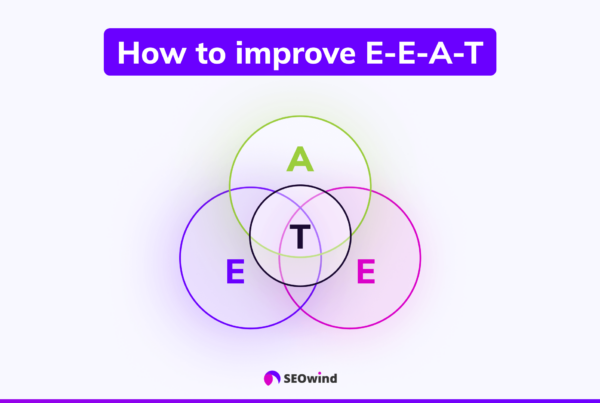Mastering the art of article writing can propel your career, establish you as an expert in your field, and drive traffic to your website or blog. Understanding how to structure and format an engaging article is critical for professional growth and capturing readers’ attention. In this comprehensive guide, we will explore the essentials of article writing format, step-by-step instructions for crafting compelling content, various types of articles, best practices for formatting an article to capture leads, and much more. Read on to elevate your skills and learn how to create stunning articles that captivate audiences.
What is the Article Writing Format?

An article writing format is a structured template that guides writers to effectively communicate their ideas through clear organization, logical development, and coherent presentation. Adhering to a well-structured manner ensures that the author’s thoughts are easily understood by readers while maintaining consistency across different components such as headings, subheadings, introduction, body text, images or infographics, and conclusion.
What is the format for article writing?
The standard format for composing an article entails six primary elements:
- Heading: A captivating title sums up the topic or expresses a unique angle.
- Introduction: An engaging opening paragraph hooks readers by introducing the subject matter while sparking curiosity.
- Body: Well-structured paragraphs are subdivided into subsections or bullet points that clearly explain each point with concise language.
- Subheadings: These break up long stretches of text into manageable sections or highlight main ideas for easy scanning.
- Images and Infographics: Visual aids complement written content by further illustrating your points or presenting complex data in simplified form.
- Conclusion: A summary reiterating key highlights without repeating exact phrases used earlier – often ending with a call-to-action to provoke reader response.
Objectives of Article Writing
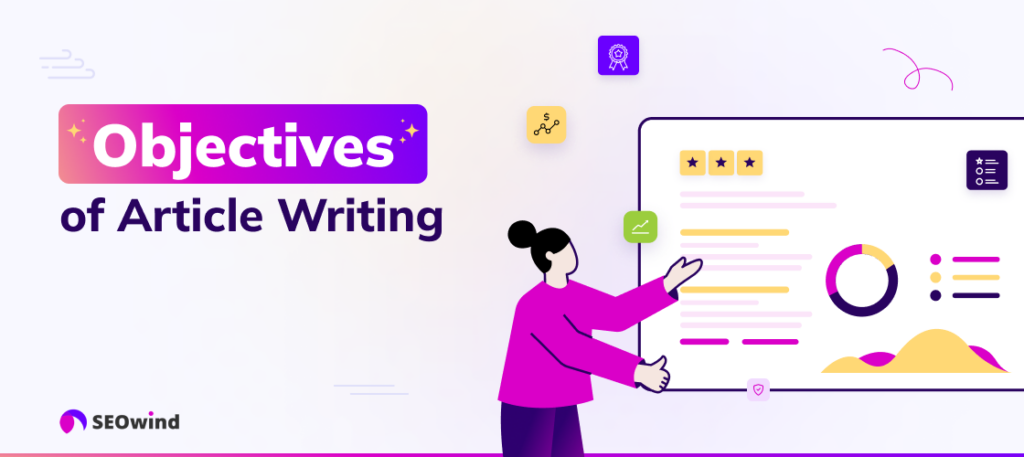
The article writing process involves various objectives to effectively communicate with your target audience. A well-crafted article serves multiple purposes, making it essential to content creation. By understanding the primary objectives of article writing, you can ensure that your content effectively meets its intended goals.
Inform and Educate
One of the key objectives of article writing is to inform and educate readers about a particular topic or subject matter. Incorporate accurate, up-to-date information backed by reliable sources into your content to achieve this goal. Providing information clearly and concisely helps maintain reader interest and enhances comprehension.
Engage the Reader
Engaging your reader is crucial to retaining their attention throughout the whole article. Utilize an active voice and conversational tone to create compelling content while maintaining professionalism. Incorporating personal anecdotes and real-life examples can make complex topics more relatable and accessible to readers.
Establish Authority and Expertise
Establishing yourself as an authoritative figure in your niche is another important objective of good article writing. To do so:
- Conduct thorough research
- Reference reputable sources
- Showcase industry expertise through insightful analysis
Expertise adds credibility to your content, encouraging readers to trust your opinions on relevant subjects.
Persuade Your Audience
When persuading readers to adopt a specific viewpoint, presenting solid arguments supported by credible evidence is vital. Employ persuasive techniques such as addressing counterarguments or providing data-driven insights to bolster your position convincingly.
Encourage Action
Some articles are written to influence readers towards taking action – whether it entails subscribing to an email newsletter, purchasing, or supporting a cause. Using persuasive language or offering incentives, such as exclusive benefits from acting promptly, can be helpful strategies for driving desired actions.
Four Types of Article Writing
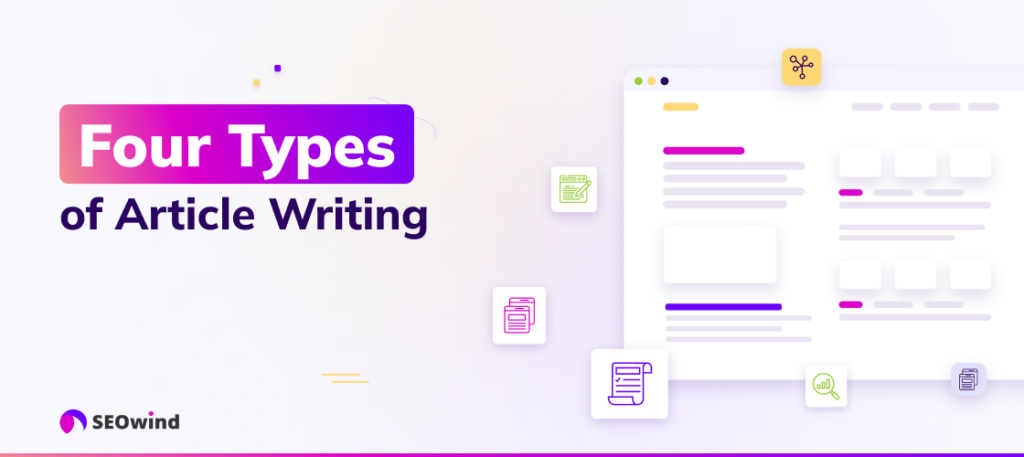
An effective content creator should have a solid understanding of the four major types of article writing. Each type has its purpose, style, and intended audience. By mastering all these formats, you’ll be able to engage different readers effectively and convey your message precisely. This section explores the characteristics of expository, persuasive, narrative, and descriptive writing styles.
Expository Article Writing
Expository writing is an informative approach that educates readers about a specific topic or concept without expressing personal views or opinions. It requires extensive research and factual accuracy to present information clearly and concisely objectively. Some common examples of this article writing format include:
- How-to guides
- Tutorials
- Product reviews
- News articles
When creating expository articles, consider the following elements:
- Develop a clear thesis statement or central idea.
- Use logical organization with headings and subheadings.
- Include credible sources and evidence to support claims.
- Keep your language precise, neutral, and easy to understand.
Persuasive Article Writing
In contrast to expository writing’s objective nature, persuasive writing articles aim to convince readers to adopt a particular viewpoint or take specific actions based on provided arguments. This article’s writing format often relies on emotional reasoning and rhetoric while incorporating strong evidence from reliable sources. Common examples of an argumentative article include opinion pieces, editorials, and product recommendations.
To craft compelling, persuasive content:
- Clearly state your position or argument.
- Provide well-reasoned points supported by facts or expert opinions.
- Address counterarguments respectfully while showing their weaknesses.
- Employ persuasive language techniques such as analogies or rhetorical questions.
Narrative Article Writing
Narrative articles focus on storytelling by sharing personal experiences or fictional tales for readers’ entertainment or enlightenment purposes. These stories typically follow chronological order with engaging characters and vivid descriptions; however, narrative-style business case studies or product testimonials can also be powerful marketing tools. Some examples are personal essays, anecdotes, and travelogues.
Tips for successful narrative writing:
- Utilize a robust and engaging hook to capture your audience’s attention.
- Develop relatable characters and realistic dialogue.
- Use descriptive language to paint a visual image for your audience.
- Follow a clear story arc with a beginning, middle, and end.
Descriptive Article Writing
Descriptive articles offer detailed descriptions of people, places, objects, or events to engage readers emotionally and create vivid mental images. Article writers often use sensory details (sight, hearing, smell, taste, touch) and figurative language (similes and metaphors) to bring the subject to life in this article’s writing format. Common instances include food reviews, travel experiences, and event reports.
To excel in descriptive writing:
- Choose a specific aspect or experience you want to convey.
- Use rich sensory information to evoke emotions or reactions.
- Employ figurative language strategically—don’t overdo it!
- Strive for an immersive experience by showing rather than telling.
Understanding these four article writing formats will allow you to craft compelling content tailored for each purpose and audience type successfully. Familiarize yourself with the unique characteristics of expository, persuasive, narrative, and descriptive styles to elevate your article-writing skills considerably.
The Article Writing Format
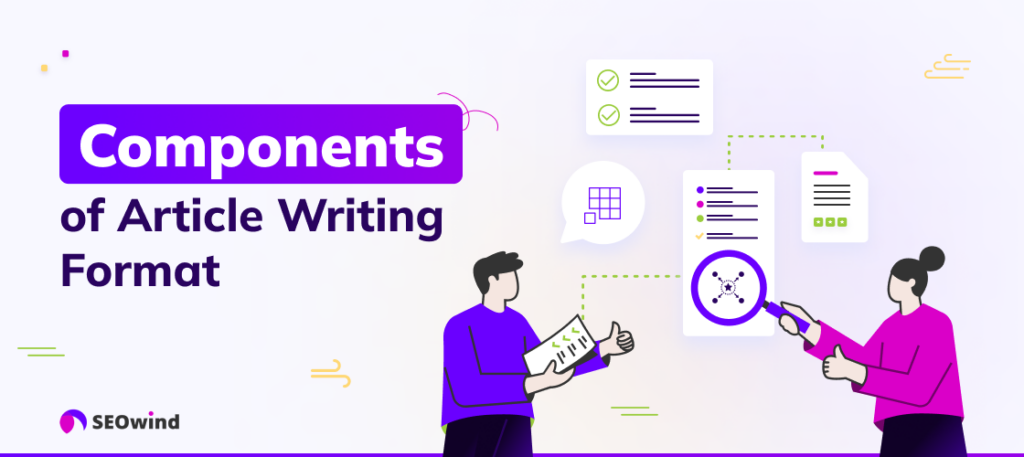
Understanding the article writing format is essential to producing high-quality, engaging content. An effective article-written format will help guide your readers through your ideas logically and clearly. This section will discuss the key components of a well-written article: Heading, Introduction, Body, and Conclusion.
Heading
An attention-grabbing heading is critical for drawing readers in. Make sure it accurately reflects the content of an article while keeping it concise and intriguing. Here are some tips you can follow:
- Use powerful vocabulary words that evoke emotion or curiosity
- Keep it short (ideally between 5-10 words)
- Avoid clickbait but make sure it generates interest
- Frame it as a question or use numbers if relevant (e.g., “5 Steps to Improve Your Sleep”)
Experiment with different formats to find what works best for your target audience when writing headings.
Introduction
The introductory paragraph sets the stage for what readers should expect from your article. It aims to hook them into reading further by providing a glimpse of the value they’ll get by continuing. To achieve this, adhere to these guidelines:
- Start with an interesting fact or statistic that demonstrates the significance of your topic.
- Establish context and relevance by addressing why this topic matters to your readers.
- Give a brief overview of what you’ll discuss without diving too deep.
- End with a thought-provoking statement or question that encourages people to read on.
Remember that a strong introduction entices readers while setting expectations for the rest of the article.
Body
The body comprises the bulk of your article content and forms the heart of its substance. In this section, elaborate on points introduced in earlier sections, supporting them with evidence such as research, anecdotal examples, clear statements, or expert quotes when necessary.
To write effectively in the body:
- Break down your main ideas into digestible subheadings to guide the reader.
- Be descriptive but concise – avoid excessive jargon and focus on conveying your key message.
- Use logical transitions between paragraphs or subsections to ensure a coherent flow of ideas.
- Utilize bullet points or numbered lists when presenting multiple concepts.
- Incorporate multimedia elements, such as images or graphics, to support and engage.
Organizing the body effectively ensures readers can easily understand and retain your present information.
Subheadings
Subheadings play a crucial role in enhancing the readability and organization of an article. They break up large chunks of text, making it easier for readers to consume the content and maintain their interest. Subheadings act as guideposts that lead the reader from one important component or topic to another, quickly conveying the essence of each section.
When incorporating subheadings into your article, consider the following tips:
- Make them informative: A good subheading should provide a snapshot of the section’s content. It should be concise yet descriptive enough to give the reader an idea of the topic that will be covered.
- Keep them consistent: Subheadings should maintain a consistent format throughout the article. This can involve using a similar font style, size, or emphasis. Consistency makes it easy for readers to recognize and navigate through different sections.
- Use SEO-friendly keywords: Including relevant keywords in your subheadings can improve the SEO (Search Engine Optimization) of your article, making it more discoverable by search engines. This strategy makes your content more likely to appear in users’ search results when they’re looking for information on your topic.
- Space them appropriately: Breaking up your content into logical sections helps improve readability. Avoid cramming too many subheadings close together or leaving large gaps between sections. A well-spaced article ensures a smooth reading experience and helps readers find the specific information they need.
- Keep paragraphs short -Ideally, paragraphs should not exceed three to five sentences in length. Focusing on one central idea per paragraph can help you create a clear and organized structure throughout your article.
Images and Infographics
Visual elements like images and infographics greatly enhance an article by providing visual appeal, enhancing understanding, and supporting the content. They can break up the lengthy text, making the content more digestible and engaging for readers.
- Use high-quality images: High-resolution images not only look professional, but they also convey your message more effectively. Ensure that the images you use are sharp, clear, and well-composed. Always credit the source of the image or make sure you have the appropriate permissions to use it.
- Relevance is key: Images and infographics should be directly related to the content they accompany. They should support the points being made and help clarify or elaborate on the information presented in the text. Avoid using irrelevant or generic images just for the sake of visual appeal.
- Opt for original visuals: Create or commission original images and infographics whenever possible. This not only adds a unique touch to your article but also helps set your content apart from others on similar topics.
- Use captions and descriptions: Including captions and descriptions with your images and infographics provides additional context and ensures that readers understand their relevance to the content. This can also improve the accessibility of your article for individuals who use screen readers or have visual impairments.
- Optimize for SEO: By including relevant keywords in the file names, alt text, and captions of your images and infographics, you can boost the overall SEO of your article. This helps search engines better understand the content and context of your visuals, making your content more discoverable.
Conclusion
A well-crafted conclusion is a closing statement that reaffirms your article’s main point(s). It reinforces what has been learned and provides direction for readers who want to explore further or take action related to your topic. Follow these tips to write a good and logical ending:
- Summarize key points made throughout the article without introducing new information.
- Highlight implications, real-world applications, or future trends relating to your subject matter.
- Invite feedback or discussion, or urge readers to consider the following steps (e.g., following a call-to-action).
- Claim your mastery by crafting an end with a thought-provoking question or inspiring quote that leaves an impact.
By effectively crafting the final paragraph, you’ll leave your audience feeling satisfied and enriched by their reading experience while wanting more from you in future articles. Ultimately, mastering this article writing format empowers you to consistently create high–quality content–benefitting you and those who read it.
Step By Step Guide for Writing an Article

To write good articles, it’s crucial to follow a systematic approach that covers all aspects of the topic. This section discusses a step-by-step guide to use as a blueprint when writing good articles.
Step 1: Identify your target audience
Before diving into the writing process, it’s essential to determine who your target audience is. Your readers’ preferences and interests will significantly influence the content of your article and its tone. To identify them:
- Define demographic characteristics such as age, gender, location, and occupation.
- Determine their needs, aspirations, confusions, or problems they are facing.
- Assess their level of expertise in your chosen topic; are they beginners or experts?
Understanding your target audience helps customize the article format and ensure the content resonates with them.
Pro Tip:
1. Remember who you’re speaking to. Understand their passions, pains, and what keeps them up at night. Once this picture becomes clear:
- Shape your content’s tone to match their preferences – heavy jargon for professionals versus simpler terms for beginners.
- Provide answers or solutions tailored specifically for them. This attentiveness ensures your articles resonate deeply and foster loyalty from those who find sanctuary in your words.
2. Readers often approach articles with clear intentions – seeking answers, learning skills, or simply finding entertainment. Your mission is thus twofold: discern these intents accurately, then craft content that aligns perfectly with their quests:
- Research keywords they use when searching online.
- Deliver content formats meeting those searched criteria—from how-to guides to thought pieces.
Aligning with search intent satisfies readers and signals search engines that your content is valuable. This leads us to our next point gracefully.
Step 2: Select an appropriate topic and an attractive heading
Next, pick one topic relevant to your niche or industry and develop an attention-grabbing headline that will pique readers’ curiosity. A captivating heading encourages potential visitors to click on your link and read through the entire piece.
Some tips for selecting topics and creating headlines:
- Address current trends or industry developments,
- Tackle issues faced by your target audience,
- Pose thought-provoking questions,
- Use numbers in listicles (e.g., “10 Tips for __”),
- Implement power words such as ‘How-to,’ ‘Ultimate Guide,’ ‘Secrets,’ etc.
Step 3: Conduct thorough research
Once you’ve chosen your topic, invest time in researching. It not only raises credibility but also helps provide well-rounded, relevant information to a larger audience of readers. As you gather data:
- Seek reliable sources like academic articles, government publications, books by renowned authors, or interviews with subject-matter experts.
- Maintain organized notes with valuable findings, including statistics, case studies, or expert opinions.
- Cross-check data to ensure its authenticity and relevance.
Step 4: Write an article outline
Creating an outline serves as the backbone of a good article, ultimately contributing to a clear and coherent content structure. Divide the piece into logical sections like:
- Introduction
- Main body (subheadings)
- Conclusion
You can further break down each section into smaller sub-sections or bullet points to make it more digestible for readers.
Step 5: Write and proofread
With your research and outline in place, begin writing using a conversational tone while keeping it professional and informative. Keep in mind the following considerations:
- Use active voice and simple sentences
- Create engaging, relatable content for your target audience
- Utilize appropriate transition phrases between ideas
- Incorporate relevant keywords throughout the article
After completing your rough draft, set aside some time before revisiting it with fresh eyes to proofread. Correct any grammatical mistakes, unclear sentences, or inconsistencies.
Use AI Tools to speed up the process
Artificial Intelligence (AI) tools can significantly help streamline the writing process. Some popular AI writing assistants include Grammarly, Hemingway Editor, INK, or Copy.ai, which offer features like grammar checks, readability score improvements, or even generating content ideas.
Step 6: Add images and infographics
Lastly, enhance your article by incorporating relevant visuals such as photos, illustrations, or infographics to aid comprehension or break up text-heavy portions. Ensure they are high-quality images, and remember to credit sources.
Pro Tip:
1. Include Relevant and High-Quality Visuals
We live in a highly visual society where images can communicate complex ideas swiftly and memorably. Enhance reader engagement by integrating visuals such as:
- Crisp photographs
- Informative charts
- Vibrant infographics
High-quality visuals serve as waypoints on the journey through your text, keeping audiences anchored and immersed.
Step 7: Optimize for SEO
Optimizing for SEO means more than sprinkling keywords throughout your text. It’s about making sure those seeking what you’ve written find it effortlessly amid the vast ocean of online information. Here lies an opportunity:
- Employ relevant keywords naturally within headings and body paragraphs.
- Anchor texts should flow smoothly with internal links, leading readers deeper into related topics on your site.
By weaving SEO strategies through each paragraph, you enhance discoverability without sacrificing quality storytelling, a balance worthy of pursuit.
Article Writing Rules – Rules for Writing Good Articles
Following basic article writing rules is essential to create compelling and high-quality articles. These rules make the process easier and ensure your content is engaging, informative, and valuable to your readers. Let’s delve into these crucial guidelines that can elevate your article-writing skills.
Use Appropriate Keywords
Naturally integrating relevant keywords helps improve your article’s visibility, search engine rankings, and engagement rates. Be sure to use 3-5 of the appropriate keywords per section without compromising the quality of your content or forcing yourself to use them unnaturally.
Be Clear and Concise
Simplicity works wonders in the world of article writing. Keep sentences short and precise with a maximum of 15 words each since shorter sentences are easier for readers to read, understand, and absorb.
Maintain Coherence
Ensure that consecutive blocks of text don’t begin with the exact phrases or words to maintain coherence throughout the entire article. Each section should expand on the content covered previously while avoiding unnecessary repetition.
Stay Focused on Your Topic
Stay focused on your chosen subject matter by providing substantial information relevant to the topic at hand—straying too far from it may leave readers confused and disinterested.
Utilize Proper Formatting
Applying appropriate formatting techniques enhances readability by breaking down large chunks of text into smaller sections using headings, subheadings, bullet points, ordered lists, etc., making it enjoyable for readers.
Apply Logical Transitional Phrases
Using logical transitional phrases between ideas significantly improves readability as they connect related thoughts smoothly instead of relying solely on conjunctions like ‘and’ or ‘but.’
Fact-Check Your Content
Validate data through reliable sources like studies or research; this practice eliminates errors and boosts your content’s credibility.
Edit and Proofread
Ensure grammatical accuracy and clarity by thoroughly editing and proofreading your work, eliminating potential distractions for your readers in the form of errors or inconsistencies. Seeking feedback from a fellow article writer, editor, or reader can be incredibly valuable for enhancing the quality of your content.
By effectively applying these rules to your article writing process, you’ll notice increased engagement while providing the readers with the information they desire in a clear and user-friendly manner. Remember that practice makes perfect, so keep refining your skills to craft exceptional articles that captivate readers’ attention and sustain their interest throughout.
Common Mistakes to Avoid in Article Writing
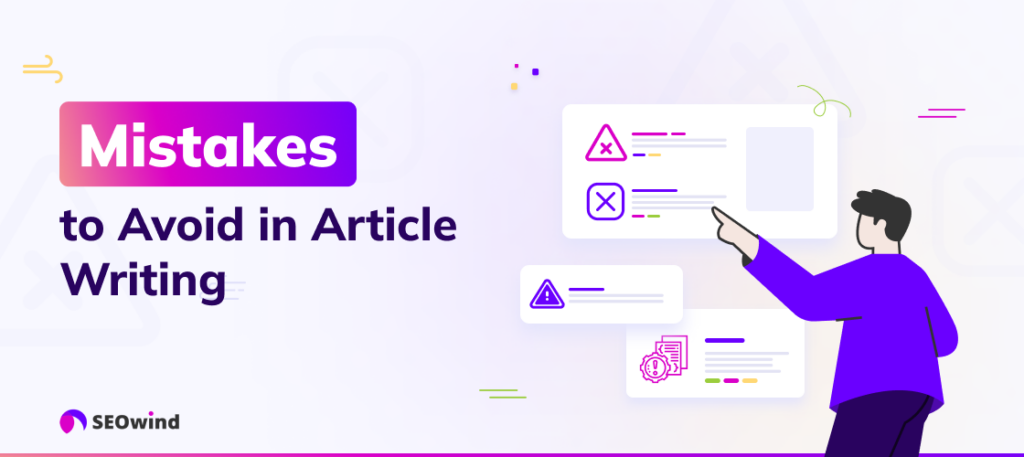
Even experienced writers can fall into common pitfalls that stall their articles from reaching their full potential. Let’s explore some frequent mistakes so you can steer clear of them.
Lack of Clarity or Coherence in Writing
Have you ever read a passage several times and still felt lost? A lack of clarity can leave readers confused and disengaged. To ensure that your thoughts flow seamlessly:
- Keep sentences short and sweet.
- Use subheadings to break up the text and organize thoughts.
- Transition smoothly between ideas with phrases like “Additionally” or “Another aspect to consider.”
Remember, article writing for websites should guide your reader through the topic like a knowledgeable friend leading the way in uncharted territory.
Poor Grammar and Spelling Errors
Nothing diminishes credibility quicker than grammar blunders or typos. They’re like little bumps on the road – each one jarring your reader from the experience.
- Utilize tools like Grammarly to catch sneaky errors.
- Never rely solely on spellcheck. Read aloud to see awkward phrasing.
- If feasible, have someone else review your work – fresh eyes find new mistakes.
Your command over language demonstrates professionalism and respect towards your audience. Don’t let simple slip-ups undercut your message.
Overuse or Misuse of Keywords
Keywords help people find your articles, but cramming them in willy-nilly makes for stilted reading. Keyword stuffing is a passe SEO tactic that today’s savvy algorithms easily spot as manipulative.
- Use keywords naturally within the context.
- Aim for keyword variations and synonyms to maintain readability.
- Concentrate on creating valuable content first; let keywords serve as subtle signposts rather than glaring billboards.
For website article writing, balance is key: enough keywords to be found by search engines but not so many that readers lose interest.
Insufficient or Inaccurate Research
In this digital age, everyone’s an expert…until they’re not. Ensure every fact you state could stand up in court if need be:
- Cross-check information against reputable sources.
- Cite statistics from authoritative studies (and link back where possible).
- Stay updated with recent data – because today’s fact might be tomorrow’s fiction.
Invest time in research – it reinforces your authority and trustworthiness as a writer much more than unfounded assertions ever could.
Lack of Originality or Unique Perspective
Lastly, don’t just rehash what’s out there. Offer something new:
- Fuse personal experience with external knowledge – it adds authenticity.
- Engage with controversial viewpoints (respectfully) to stimulate discussion.
- Present solutions, not just problems – be helpful, insightful, and inspirational.
Originality will set you apart from the informational echo chamber that often inundates web searches. Stand out by being distinctly YOU when engaging in article writing for website topics – it’s about adding value through unique insight as much as imparting wisdom through words.
How Should an Article Be Written?
The article writing process varies based on available resources and the chosen approach. To create compelling content, you have several options: hiring a freelancer, engaging an agency, or utilizing AI writing tools. Each method has its advantages and drawbacks. Let’s examine each option in detail.
Freelancer Article Writers
Hiring a freelancer is often the go-to choice for businesses seeking to outsource their article-writing tasks. By choosing this route, you gain access to various benefits:
- Expertise: Freelance writers possess diverse skill sets to tackle multiple topics in different formats.
- Flexibility: Working with a freelancer enables flexibility regarding deadlines and communication.
- Cost Savings: Hiring freelancers may result in cost savings compared to engaging with an agency.
However, possible challenges include inconsistency in quality and uncertainties surrounding accountability.
When considering freelance writers for your articles, keep these guidelines in mind:
- Review their portfolio, focusing on relevant samples;
- Check online reviews or seek recommendations;
- Communicate your expectations regarding format, tone, and style;
- Discuss project timelines and payment terms.
Agency
Collaborating with an agency can provide access to comprehensive expertise while maintaining consistent results. Agencies typically offer teams of writers, editors, and graphic designers who work together cohesively on your projects.
Benefits of working with an agency include:
- Consistency: A professional agency ensures overall consistency across all content produced.
- Scalability: An agency can handle large-scale projects more efficiently than individual freelancers.
- Streamlined Communication: Agencies usually assign a dedicated project manager for efficient communication.
On the downside, agencies tend to be more expensive than freelancers.
To find the right fit when exploring agency options:
- Research reputable agencies within your niche;
- Evaluate their offerings by verifying case studies or reviews;
- Discuss project scope, schedule, and budget before signing agreements.
AI Article Writer
Artificial Intelligence (AI) writing tools like SEOwind have emerged as innovative solutions for content creation. These programs rely on advanced algorithms to generate articles at a faster pace. However, the degree of human involvement is still crucial for maintaining quality and effectiveness.
Some advantages of AI writing tools include the following:
- Efficiency: AI-powered tools can generate articles swiftly, which may save time compared to manual writing.
- Content Ideas Generation: They can provide content suggestions based on your chosen keywords or topics.
- Proofreading and Editing: Many AI tools also assist in improving readability by identifying grammar errors and suggesting sentence structure improvements.
There are limitations when relying solely on AI-generated content, such as a potential lack of creativity, knowing the specifics of your domain or company, and problems with factual data.
To successfully leverage AI writing tools:
- Research reliable options that address your specific needs;
- Use them alongside human input, striking a balance between automation and human touch;
- Ensure thorough editing before publishing any AI-generated article.
Each method – freelancer, agency, or AI writing tool – has its strengths when creating articles that follow the ideal format. The key is understanding your requirements while ensuring your chosen approach complements your goals regarding quality, efficiency, and budget constraints in article production.
How Can I Start Writing Articles?

Starting to write articles may seem overwhelming, but with a step-by-step approach and understanding of the article writing format, you can successfully begin your journey. Here are some essential steps to consider when starting:
Define Your Interests and Expertise
Before delving into article writing, recognize your interests and areas of expertise. This will guide you in choosing relevant topics that align with your passion and knowledge.
Identify a Target Audience
Knowing your audience is crucial for any content creation. Understand your target readership’s demographics, preferences, needs, and language style.
Choose Article Writing Topics Wisely
Pick engaging topics based on current trends or issues your target audience faces. Conduct keyword research to identify popular search phrases related to the subject matter.
Learn Article Writing Fundamentals
Familiarize yourself with the components of an article writing format, such as heading, introduction, body, and conclusion. Study sample articles related to your niche to understand how professionals structure their work.
Plan Your Content
Create an outline before beginning the actual writing process. This will help you organize thoughts effectively while covering all necessary points within the content.
Write Regularly
Refining your skills takes time and practice; make it a priority to write consistently (daily or at least several times per week). Ensure you maintain focus on quality over quantity during this learning phase.
Edit Thoroughly
Reviewing your work is essential when crafting high-quality articles; eliminate errors or redundancy within sentences to ensure conciseness and clarity in communication.
Seek Feedback
Ask friends, family members, or colleagues for honest feedback regarding writing style, flow, tone, and accuracy — constructive criticism contributes to writing growth.
Expand into Different Formats
Experimentation allows improvement; explore different article formats, such as persuasive or descriptive writing, to strengthen your versatility in content creation.
Learn from Others
Study articles by other writers within your niche to observe their techniques and styles. Analyzing their approach empowers you to develop your unique voice over time.
Starting a career in article writing begins with self-awareness and an understanding of the target audience’s needs. Building a solid foundation in the essentials of article writing format, followed by consistent practice, leads to growth and success in this field. Embrace feedback and continuously challenge yourself by exploring various formats, styles, and niches within written communication.
Grow Your Article Writing with a Focused Niche

Choosing a focused niche is essential in honing your article writing skills, building credibility within your industry, and positioning yourself as an authority. A narrow niche will enable you to create specialized content that appeals to your target audience and meets their unique needs.
Benefits of Selecting a Specific Niche
- Expertise: A concentrated focus allows you to deepen your understanding of the subject matter and build expertise – vital components for creating high-quality articles.
- Targeted content: You can craft content tailored to your intended audience’s challenges and aspirations by zeroing in on a particular area.
- Establish authority and credibility: Writing informative articles on topics related to your niche over time will help position you as an authoritative voice.
- Audience loyalty: Readers searching for information about a specific topic are more likely to return for additional insights from writers who consistently provide valuable content in their area of interest.
- Higher relevance for SEO: Focusing on a specific type of content or set of keywords improves search engine optimization (SEO) performance because search engines find ranking pages containing relevant, authoritative information easier.
To succeed in growing your article writing by concentrating on one area, consider these strategies:
Identifying Your Niche
Selecting a suitable niche requires careful assessment of both personal interests and market demands. Aligning these two factors ensures sustained motivation while creating ample opportunities for professional growth.
- Evaluate personal passions: Choose a subject that genuinely fascinates or excites you since this will reflect positively on the quality and tone of your articles.
- Discover areas where readers need answers: Identify niches with insufficient high-quality content or new developments driving demand for updated resources.
- Assess competition: Research how other writers fare in potential niches by analyzing the format, quality, and reader engagement of existing articles.
Staying Updated in Your Niche
Once you have selected your niche, you must stay informed about new technical developments and trends within the industry. This will enable you to:
- Produce articles that are up-to-date and relevant,
- Address the ever-changing needs of your target readers,
- Offer insights based on recent research and findings.
To remain current, tap into resources such as:
- Industry news websites or reputable blogs,
- Research publications from authoritative sources,
- Online communities or social media groups related to your niche.
Adapting Article Writing Format for Your Niche
An effective article writing format resonates with your specific audience by addressing their unique concerns and interests. To tailor your article format for maximum effectiveness within your chosen niche:
- Understand your audience: Identify the content preferences, knowledge level, and reading habits of people interested in your niche.
- Customize headings: Use headings that reflect your target readers’ challenges or offer potential solutions specific to their context.
- Adjust tone and vocabulary: Write using an appropriate tone of voice (professional or conversational) while incorporating industry-specific jargon where necessary to enhance credibility.
- Create captivating introductions: Design introductions that grab attention with compelling hooks tied specifically to questions and concerns within the domain.
- Structure articles for easy scanning: Utilize subheadings, bullet points, numbered lists, and text formatting techniques such as boldface or italics to improve readability.
How Do I Know It’s a Good Niche?
Selecting the right niche is critical for successful article writing. A good niche is one that not only piques your interest but also has a substantial demand and audience. To determine if a specific niche is worth pursuing, consider the following factors:
Interest and Passion
First and foremost, check whether you have a genuine interest in the niche. Writing about something you are passionate about will make producing engaging and informative content easier. Having expertise in the subject matter also provides an added advantage.
Available Audience
A strong market presence with an existing audience indicates a potentially profitable niche. Use keyword research tools like Google Keyword Planner or Ubersuggest to identify search volume trends on related topics within the chosen niche.
Competition
Analyze your competition before committing to any specific topic. Suppose there’s low competition for a particular keyword set or subtopic. In that case, it may be wise to pursue it further to position yourself as an authoritative source of information.
- High competition: Beware of overcrowded subjects where standing out from other writers might prove challenging.
- Moderate competition: Optimal scenario – there’s enough interest surrounding the topic, yet room exists to establish your voice as an expert.
- Low competition: Assess if low demand or limited content quality is causing fewer people to write about this subject; high-quality articles might still attract readership.
Monetization Potential
If generating income through article writing is part of your goals, assess the monetization potential for your chosen niche. Consider options such as affiliate marketing programs, sponsored posts, advertising revenue, or even creating eBooks based on your articles.
Evergreen Content Possibilities
Lastly, evaluate if your selected niche lends itself well to producing evergreen content – timeless information that remains relevant regardless of when it was published. Establishing evergreen content ensures steady traffic flow over time without constantly needing updates or relying solely on trending topics.
Considering these factors, you can ascertain if your chosen niche will lead to profitable and engaging article-writing experiences. As your expertise grows within a specific niche, generating fresh content and captivating readers will become increasingly effortless, allowing you to leverage your skills for greater success.
What is the Best Article Writing Format to Capture Leads?

Capturing leads through effective article writing has become essential in reaching your target audience and driving conversions. Creating quality content that resonates with readers in various formats helps showcase your expertise, fostering credibility and trust. To determine the best format for efficiently capturing leads using articles, consider incorporating these key elements:
Attention-Grabbing Headline
An enticing headline works as a hook that can grab the reader’s attention and pique their interest before they even start reading your content. Make sure to use powerful words that resonate with your target audience and ensure it demonstrates the value they would receive by reading the article.
Introduction with Strong Value Proposition
The introduction to the perfect article should be engaging and provide a quick overview of what the reader can expect from the article. A solid value proposition is often indispensable in establishing why this piece will benefit them or solve their problem.
Include Infographics, Images, and Videos
Visual aid helps break up long walls of text and adds depth to your content while making it more appealing to readers. Including relevant infographics, images, or videos within an article enriches user experience leading to better engagement rates.
Easy-to-Digest Content Format
Consider employing one of these formats for better comprehension:
- Bullet points: They allow easy scanning.
- Subheadings: Allow breaking complex topics into smaller sections.
- Short paragraphs: Simplify structure while maintaining readability.
Remember to keep sentences short (up to 15 words) for better readability.
Call-to-Action (CTA)
Including a strong call-to-action at strategic points throughout the article encourages readers to download resources such as e-books or sign up for newsletters–thus capturing leads effectively.
Overall, choosing an article writing format highly depends on understanding which method resonates most with your target audience and the type of content produced. Experimenting with several approaches lets you ascertain which format yields better lead-capture results while consistently delivering value through compelling and informative content.
Frequently Asked Questions (FAQs) on Article Writing
The journey of writing articles is filled with questions. Let’s tackle a few pressing queries to help you navigate the art of article writing.
What is the Ideal Length for an Article?
Ah, the age-old question: “How long should my article be?” There isn’t a one-size-fits-all answer. It depends largely on your audience, topic complexity, and publication venue. However, a rule of thumb suggests:
- Short-form articles typically range from 500 to 800 words and are superb for online platforms where readers seek quick insights.
- Medium-length articles, hovering around 1,200 to 1,500 words, hit a sweet spot by providing enough space to delve deeper without over-testing readers’ attention spans.
- Long-form pieces stretch beyond 2,000 words and suit topics requiring comprehensive coverage or detailed storytelling.
Assessing what you aim to achieve with what an article in writing is helps solidify this decision. Remember engagement metrics because reader retention can drop if content feels needlessly drawn out.
Can I Use References or Citations in My Articles?
Absolutely! Referencing authoritative sources underpins your credibility and enriches your work by demonstrating thorough research. When you’re mulling over how to write articles for publication, consider these citation tips:
- Choose reliable sources such as scholarly journals or recognized experts in the field.
- Following the recommended citation style to bolster professionalism – APA, MLA, Chicago/Turabian are common picks.
- Include citations when stating facts or figures that aren’t common knowledge.
Incorporating references demonstrates due diligence and respect towards intellectual property rights, a sign of meticulous writing articles ethos.
How Can I Make My Articles Stand Out from Others?
Every writer desires their prose to pop off the page—or screen—as uniquely compelling. Achieving standout status hinges on the following:
- Offering fresh perspectives: Bring something new to the table—uncommon insights, novel angles, or untold stories can distinguish your piece from others cluttering cyberspace.
- Engaging narrative: Storytelling isn’t just for fiction writers. Weaving anecdotes or creating vivid scenarios makes any topic more relatable and memorable.
- Voice authenticity: Your voice is as distinct as your fingerprints. Don’t be afraid to let your personality shine through while addressing an article in writing—readers gravitate toward authenticity.
Alongside exceptional content quality goes impeccable presentation—sleek formatting and crisp visuals if applicable—and applying solid SEO practices heightens visibility. Take care not only about what you say but how you say it. That’s how lasting impressions are made daily amidst the crowded cacophony of content.
Remember that these FAQs reflect just a fraction of considerations central to crafting successful articles. Dive into each phase with curiosity and caution for the best results!


